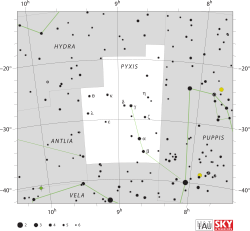Star in the constellation Pyxis
Lambda Pyxidis (λ Pyxidis ) is a yellow-hued star in the southern constellation of Pyxis . It is visible to the naked eye, having an apparent visual magnitude of 4.68. Based upon an annual parallax shift of 16.98 mas as seen from Earth, it is located around 192 light years from the Sun.
Measurements of changes in the star's proper motion over time indicate this is an astrometric binary system. The visible component is an evolved G-type giant star with a stellar classification of G8.5 IIIb Fe−1 and a spectrum that displays an underabundance of iron with weak cyanogen lines . It is a red clump star that is generating energy through the fusion of helium at its core.
Lambda Pyxidis has double the mass of the Sun and is an estimated 1.3 billion years old. It is radiating 49 times the Sun's luminosity from its photosphere at an effective temperature of 5,126 K.
References
^ van Leeuwen, F. (2007), "Validation of the new Hipparcos reduction", Astronomy and Astrophysics , 474 (2): 653–664, arXiv :0708.1752 , Bibcode :2007A&A...474..653V , doi :10.1051/0004-6361:20078357 , S2CID 18759600 .
^ Johnson, H. L.; et al. (1966), "UBVRIJKL photometry of the bright stars", Communications of the Lunar and Planetary Laboratory , 4 (99): 99, Bibcode :1966CoLPL...4...99J .
^ Keenan, Philip C.; McNeil, Raymond C. (1989), "The Perkins catalog of revised MK types for the cooler stars", Astrophysical Journal Supplement Series , 71 : 245, Bibcode :1989ApJS...71..245K , doi :10.1086/191373 .
^ Luck, R. Earle (2015), "Abundances in the Local Region. I. G and K Giants", The Astronomical Journal , 150 (3): 88, arXiv :1507.01466 , Bibcode :2015AJ....150...88L , doi :10.1088/0004-6256/150/3/88 , S2CID 118505114 .
^ Ammler-von Eiff, Matthias; Reiners, Ansgar (June 2012), "New measurements of rotation and differential rotation in A-F stars: are there two populations of differentially rotating stars?", Astronomy & Astrophysics , 542 : A116, arXiv :1204.2459 , Bibcode :2012A&A...542A.116A , doi :10.1051/0004-6361/201118724 , S2CID 53666672 .
^ Alves, S.; et al. (April 2015), "Determination of the spectroscopic stellar parameters for 257 field giant stars", Monthly Notices of the Royal Astronomical Society , 448 (3): 2749–2765, arXiv :1503.02556 , Bibcode :2015MNRAS.448.2749A , doi :10.1093/mnras/stv189 , S2CID 119217930 .
"lam Pyx" . SIMBAD Centre de données astronomiques de Strasbourg . Retrieved 2017-07-16.{{cite web }}: CS1 maint: postscript (link )
Luck, R. Earle (February 1991), "Chemical abundances for cyanogen-weak giants", Astrophysical Journal Supplement Series , 75 : 579–610, Bibcode :1991ApJS...75..579L , doi :10.1086/191542
Alves, David R. (August 2000), "K-Band Calibration of the Red Clump Luminosity", The Astrophysical Journal , 539 (2): 732–741, arXiv :astro-ph/0003329 , Bibcode :2000ApJ...539..732A , doi :10.1086/309278 , S2CID 16673121 .
Categories :
Lambda Pyxidis
Add topic
Text is available under the Creative Commons Attribution-ShareAlike License. Additional terms may apply.
**DISCLAIMER** We are not affiliated with Wikipedia, and Cloudflare.
The information presented on this site is for general informational purposes only and does not constitute medical advice.
You should always have a personal consultation with a healthcare professional before making changes to your diet, medication, or exercise routine.
AI helps with the correspondence in our chat.
We participate in an affiliate program. If you buy something through a link, we may earn a commission 💕
↑
